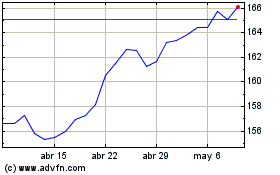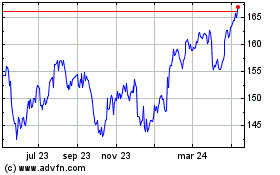By Sharon Terlep
Procter & Gamble Co. has spent years searching for a
smash-hit new product. Now the maker of Tide detergent and Gillette
razors hopes bug spray will break the drought.
The Cincinnati consumer-products giant is rolling out a line of
household insecticides safe for pets and people. The brand, called
Zevo, offers bug-killing sprays and an indoor trap for winged
insects. P&G hopes to eventually expand into safer topical and
outdoor bug killers.
It is the first creation to hit stores from P&G's
four-year-old Ventures unit, which seeks new business opportunities
and has become more important to P&G as the company works to
woo consumers increasingly drawn to niche and online-only
brands.
"People are stuck with this inevitable trade-off of, 'How do I
get rid of bugs without doing harm to my family?' " said Patrick
Kraus, Zevo marketing director, explaining the appeal to P&G of
getting into insecticides. "There's a tension there."
Zevo will go up against S.C. Johnson & Son Inc.'s Raid brand
sprays, which control nearly half the U.S. market and cost about
one-third as much. A 20-ounce can of Raid ant killer costs $4.27
online at Home Depot; a 10-ounce can of Zevo costs $6.97.
The difference is in the warning label. Children and pets should
stay away from surfaces treated by Raid, including the version
marked as safe for children and pets, according to Raid cans. Zevo
requires no such warning, Mr. Kraus said, because it uses a
chemical benign to humans and animals that targets a receptor found
only in insects' nervous systems.
S.C. Johnson said its products go through extensive risk
assessment and safety and efficacy testing. "When used according to
label directions, consumers can use all S.C. Johnson products with
confidence," the company said.
P&G acquired the spray technology from Envance Technologies,
a Morrisville, N.C.-based chemical company, which remains involved
in developing new products. A decade ago, P&G executives
decided against buying the same technology because the company felt
insecticide didn't fit its portfolio.
Zevo's other product, a box which uses ultraviolet light to draw
insects into a sticky cartridge that traps and kills them, came
from a pair of entrepreneurs who sold it to P&G in 2017. The
company didn't disclose financial terms of either deal.
Zevo products went on sale in Target Corp. stores this spring.
P&G started selling the box online in 2017, and began selling
the sprays online and in Home Depot last year.
Pest control, including topical, household and outdoor products,
is a $1.3 billion industry in the U.S., which has increased 6% over
the past four years, according to Nielsen. Raid has 49% of the U.S.
market, followed by Spectrum Brand Holdings Inc.'s Hot Shot brand
with 14% share, according to Euromonitor.
Breaking Raid's hold on the industry will be tough, especially
because people generally buy insecticides at home-improvement
retailers such as Home Depot and Lowe's, where P&G doesn't have
the same cachet, SunTrust analyst Bill Chappell said.
"S.C. Johnson has some pretty sharp elbows and a lot invested in
the space," he said. "It sounds great but do they have the pull
where the product is bought, and is the message something people
are really dying for?"
Beyond the U.S., demand for insecticides is growing quickly,
particularly in China, P&G's Mr. Kraus said. While S.C. Johnson
dominates its home market, the company's share of the $8.7 billion
global home insecticides market is 27%, according to Euromonitor.
Much of P&G's research focuses on critters living in overseas
markets.
For P&G, the Zevo rollout marks a different way of doing
business. For years, the company has struggled with bureaucracy
that often slowed and complicated product development. Its latest
billion-dollar business, Tide Pods, was released in 2012.
"We had to change the culture internally," said Leigh Radford,
general manager of the P&G Ventures unit. "It is about taking
the complexity out of the decision-making process -- a decision
should not take more than 24 hours."
P&G sales have picked up this year following price increases
on staples from diapers to toilet paper, and an internal
reorganization amid the company's proxy fight with activist
investor Nelson Peltz, who now sits on the company's board. Ms.
Radford said P&G's big business units have begun to integrate
some of Ventures' strategies.
Where roughly 200 people worked on one of P&G's last big
breakthroughs, the Swiffer mops, the Zevo team is 20 people, about
half of whom are working on other projects. Ventures works on
developing products in categories in which P&G has no
products.
Zevo began as an online-only brand, allowing the company to
quickly and directly glean consumer feedback. And rather than
building up a lab and hiring scientists, P&G rented space from
the nearby University of Cincinnati and tapped its entomologists
for bug expertise.
Gary Stibel, chief executive of New England Consulting Group,
said he recommended to P&G that it acquire the technology a
decade ago. It would have been a good investment then, he said, and
still is. "Nobody wants their pet to get sick," he said, "because
they are licking something off the floor."
Write to Sharon Terlep at sharon.terlep@wsj.com
(END) Dow Jones Newswires
July 08, 2019 05:44 ET (09:44 GMT)
Copyright (c) 2019 Dow Jones & Company, Inc.
Procter and Gamble (NYSE:PG)
Gráfica de Acción Histórica
De Mar 2024 a Abr 2024

Procter and Gamble (NYSE:PG)
Gráfica de Acción Histórica
De Abr 2023 a Abr 2024
